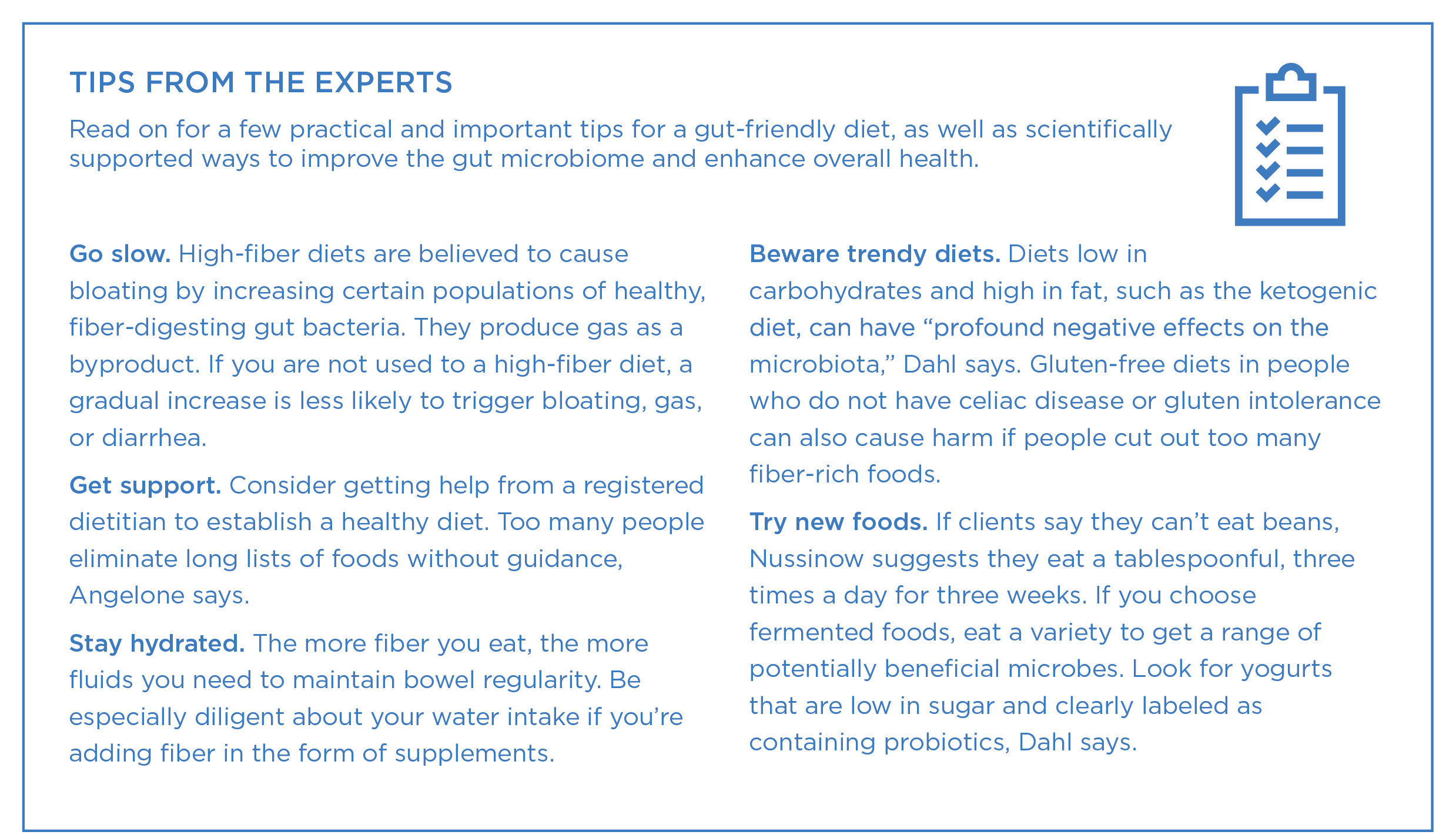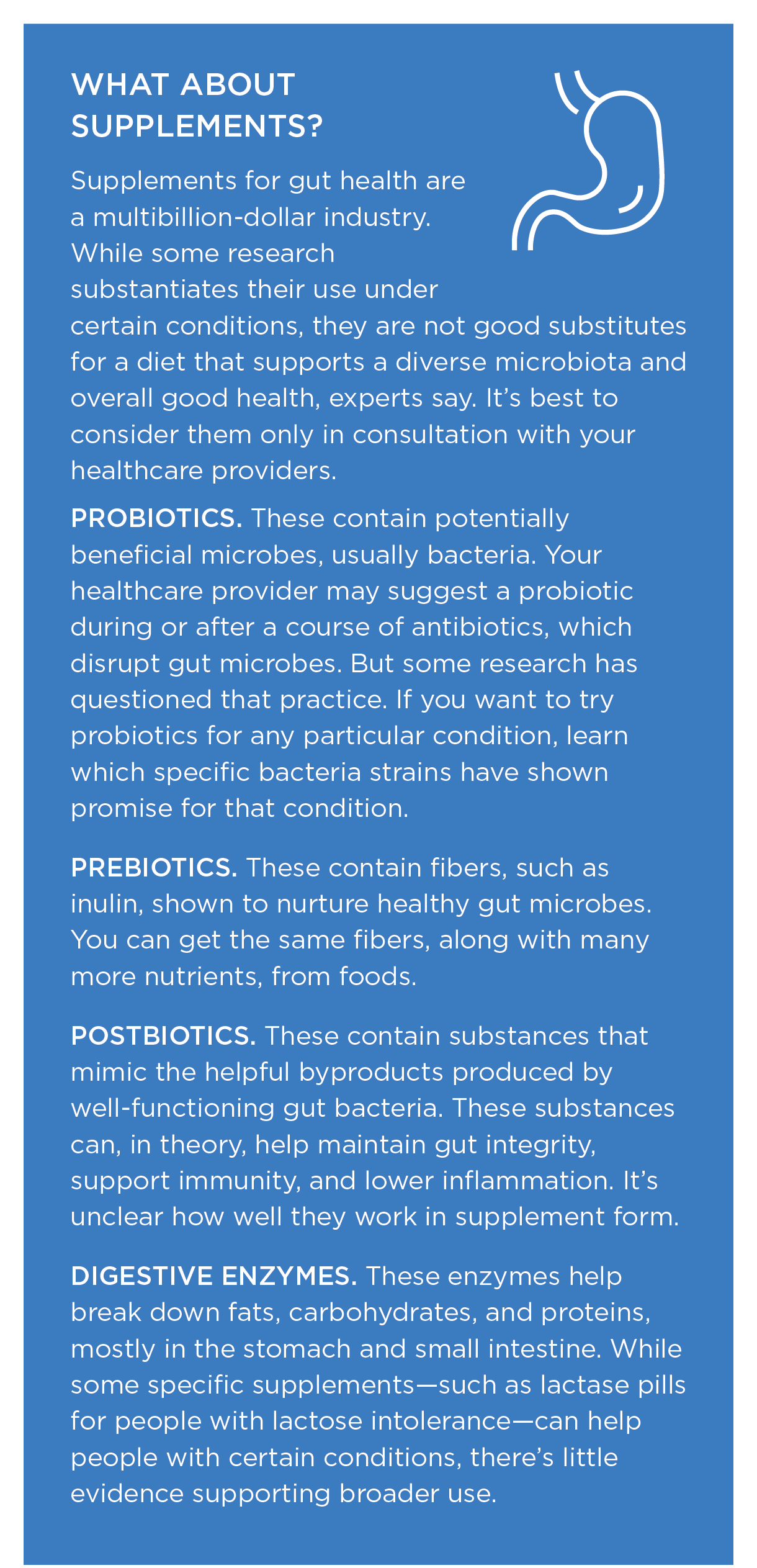Gut Check
It’s a good thing we have collective names for these houseguests. After all, there are about 100 trillion of them, mostly bacteria, in our digestive systems alone. And they are not all alike: Hundreds of species live in the average colon. So, while you don’t need to get to know them individually, you should probably think of them more than you do, health experts say.
These microbes “have a very symbiotic relationship with us,” says Sonya Angelone, a registered dietitian in San Francisco and a spokesperson for the Academy of Nutrition and Dietetics. “We need them for good health. And they need us. They’re like pets, only smaller.”
And, like pets, the microbes in our guts are forced, for good and ill, to adjust to our lifestyle choices. When we choose apples over cheeseburgers and brisk walks over sofa time, our microbes, in their own way, notice. They repay us for healthier choices in ways that scientists are just beginning to understand.
It now appears that these microbes play key roles in regulating the immune system and may affect a long list of conditions, including obesity, diabetes, heart disease, and, of course, disturbances in the digestive system itself. The mix of microbes in your gut might even influence your appetite and your mood.
“We think about our gut health as just about our gut, but it rules the rest of our body,” says Jill Nussinow, a registered dietitian in Santa Rosa, California, who has written several books on vegan cooking. “When something is good for your gut, it’s good for you.”
But what is good for your gut or, more specifically, the bugs that live there? Some of the answers may surprise you.
Diversity Is Good
Like fingerprints, no two gut microbiomes are the same. Your gut is different from your neighbor’s, and intriguingly, the guts of people from different cultures around the world tend to be quite different from one another. That genetic variation has allowed scientists to study the associations between certain microbial patterns and differences in lifestyle and health.
One key finding: People with greater diversity in their gut microbiomes—a higher number of species—tend, on average, to be healthier. While cause-and-effect relationships have not been established, lower diversity has been found in people with conditions including inflammatory bowel disease, type 2 diabetes, psoriatic arthritis, eczema, and cardiovascular disease. Some studies have found a link between obesity and low gut diversity; others have not.
Another key finding: Western diets, high in fat and processed foods, are associated with lower gut diversity than are diets higher in plants and whole foods.
“We are a long way from being able to clearly describe what is a healthy microbiota, and there are likely many pathways to [it],” says Wendy Dahl, an associate professor of nutritional sciences at the University of Florida. But, she says, “It’s generally thought that high diversity is good and low diversity is maybe not.”
The reason diversity might matter, she and other experts say, is that the microbes in our guts are down there doing important work. And they are specialists: Think of a hard-hat crew that includes the equivalent of carpenters, roofers, plumbers, bulldozer operators, and the like. Now imagine that each of these groups prefers a different diet, but you are delivering food that only the bulldozer guys will eat. Pretty soon, the rest of the crew all but disappears, and you’ve got a leaky roof, rusted pipes, and crumbling walls.
And some of the microbes left behind may be real troublemakers—bugs that prefer eating the lining of your gut to eating whatever food you send down. That may be a pathway to a condition sometimes called leaky gut, in which microbes and food particles escape the gut, potentially triggering inflammation, not only in the digestive system but throughout the body.
The good news about a messed-up microbiota? “You can change it,” Nussinow says.
Feed Your Friends
When most Americans think about eating better for gut health, they probably think about probiotics—beneficial microbes found in or added to fermented foods or supplements. Potential sources include some yogurts, sourdough bread, sauerkraut, kombucha teas, kefir (cultured milk), Japanese miso (a soybean paste), and Korean kimchi (a vegetable mix typically served as a condiment or side dish). All contain live microorganisms that might have some beneficial effects. In some circles, fermented foods have become trendy, with aficionados exchanging home fermentation recipes and getting together for festivals and impromptu kraut mobs.
Nutrition educators say these foods can play a role in day-to-day gut wellness. But they are not the secret to long-term microbial bliss. Among the reasons: The microbes in foods (or supplements) do not all survive the digestive process, and even when they do, they do not take up permanent residence in your gut. They are, at best, friendly visitors. There’s also the question of whether the particular bacteria in any batch of sauerkraut or carton of yogurt happens to be what your gut needs that day.
But there is one kind of food that experts agree is good for every gut, every day—and it’s something woefully lacking in most American diets: good old-fashioned fiber.
“In the past, we thought that all fiber was good for was to relieve constipation and, in the case of soluble fiber—like that found in oatmeal—lower your cholesterol,” Angelone says.
But now, she and other experts say, fiber is known to be the most important food source for the microbes in our colons that produce the most benefits. These microbes have evolved to make use of food remnants that travel through the upper digestive tract largely intact—the hard-to-digest fibers in fruits, vegetables, whole grains, beans, and nuts.
The average American adult gets just 17 grams of fiber each day, instead of the recommended 25 to 35 grams, recent research shows. That’s the result of a diet with too few whole, unprocessed foods, Dahl says.
“Probably the biggest problem with our ultra-processed diet is that we are starving our microbes,” she says. That’s the root cause of our often-underpopulated guts, she adds.
And the answer, according to Dahl, is not to load up on fiber supplements or any one food. It turns out that different beneficial microbes feed on different kinds of fiber. So, “a diverse, fiber-containing diet is going to support diverse microbes,” she says.

Details, Details
That’s not to say that all foods with fiber are created equal. Some foods are particularly rich in so-called prebiotics, substances known to feed beneficial microbes. The list includes onions, garlic, leeks, jicama, asparagus, and Jerusalem artichokes.
Another kind of fiber with special benefits is resistant starch. Unlike starches that are digested quickly, raising blood glucose levels, these are starches that arrive undigested in your colon, where they feed some especially helpful microbes. Sources include plantains, green bananas, white beans, lentils, and whole grains such as oats and barley.

Resistant starch also can be created in your kitchen from a few foods that might surprise some healthy eaters: potatoes, rice, and pasta. The secret is that you have to cool these foods after cooking them to produce high levels of resistant starch. You can then eat them cold or reheated. In practical terms, that means leaving cooked rice, potatoes, or pasta in the refrigerator overnight before enjoying them, Angelone says.
Lifestyle Factors
A healthy gut is about more than what you eat. It’s also about what you do.
One big factor: exercise. Regular exercisers tend to have healthier guts with higher counts of bacteria thought to fight inflammation. It’s unclear why. Exercise may be especially important in establishing the microbiome in childhood. And it might be one way for older adults to stave off age-related declines in microbe diversity.
Another factor: stress. Stress hormones can disrupt gut microbes in ways that promote inflammation. Stress-eating can also wreak havoc, of course.
And then there are antibiotics. Antibiotics are meant to kill harmful bacteria, but often kill helpful strains too. The gut fallout—which can range from brief bouts of diarrhea to life-threatening infections with drug-resistant bacteria—is a good reason to avoid these medications except when needed.
The bottom line: There’s a lot you can do to nurture a healthy gut. Start with a varied fiber-rich diet. Sprinkle in foods containing probiotics that might help keep digestive microbes in balance. Consider supplements only in consultation with your doctor. Get or stay active. And do what you can to avoid and manage stress. Be good to your gut and your gut will be good to you.